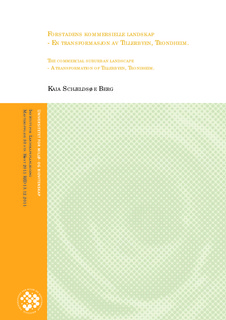| dc.description.abstract | Oppgaven har tatt utgangspunkt i planer for omforming av forstadens kommersielle landskap med en case på Tillerbyen i Trondheim. Ved å se på forstadens kommersielle landskap og prosessene som ligger til grunn for dagens situasjon, fremmes det et forslag til en fremtidig strategi. Teori fra Sverige og Danmark ligger til grunn for redegjørelsen av forstaden og de strukturelle elementene den er bygd opp av. Infrastrukturen, handelen og bebyggelsen ligger til grunn for en diskusjon av veiens tverrsnitt og hierarki, og møteplasser i det kommersielle landskapet.
Casen ser nærmere på et spesifikt område: Tillerbyen i Trondheim, og redegjør for utviklingen av en forstad fra visjon til virkelighet. Den redegjør for prosesser i samtiden og avstanden fra intensjon til bygd virkelighet. Casen understøttes av en landskapsanalyse av prosjektområdet som behandler forstaden som et mellomland mellom by og land, og fremmer forstadens landskapelige og urbane kvaliteter.
Teorien, case og analyse leder til en landskapsstrategi for Tillerbyen, kalt 2.0, som restrukturerer dagens kommersielle landskap og tilfører det den menneskelige dimensjonen det idag ikke har.
The thesis is based on plans that suggest a reshaping of the suburban commercial landscape with a case study of Tillerbyen, a neighborhood in Trondheim. By looking at the commercial suburban landscape and the processes that make up today’ situation, a strategy for reshaping suburban landscape in the future is proposed.
Relevant theory from Denmark and Sweden is at the basis of a discussion that looks at suburbia’ structural elements. The infrastructure, shopping centers and built environment is used to help shape a discussion of the road - its cross section and current hierarchy. Secondly it contributes to the discussion of public space in commercial landscape.
The case study looks specifically at one area: Tillerbyen, a neighborhood in Trondheim. In order to make account of the development of a suburb, from vision to reality, the case looks into processes throughout the years to get a picture of the distance from idea to built environment. The case study is supported by a landscape analysis of the site that treat suburbia as a place in between town and country in order to emphasize both landscape and urban qualities. The theory, case study and analysis all lead up to a landscape strategy for Tillerbyen, known as 2.0, which restructure today’ commercial landscape and add a human dimension which currently does not have. | no_NO |
